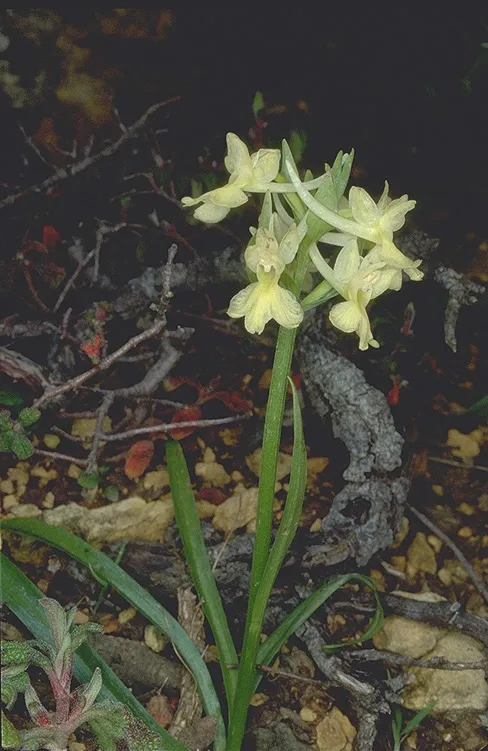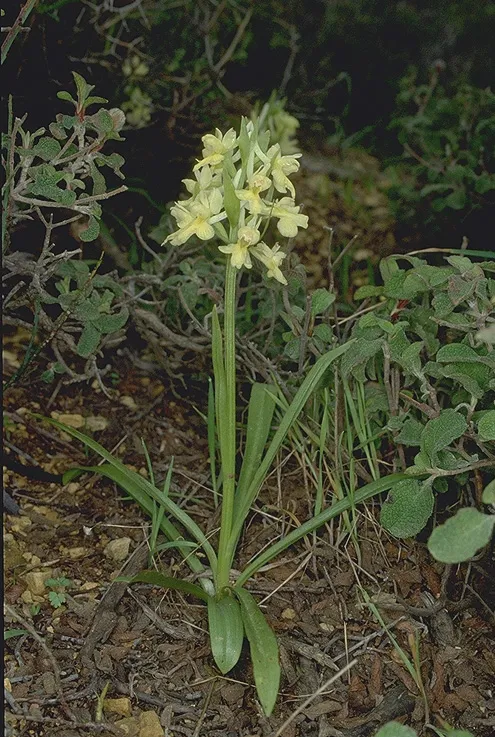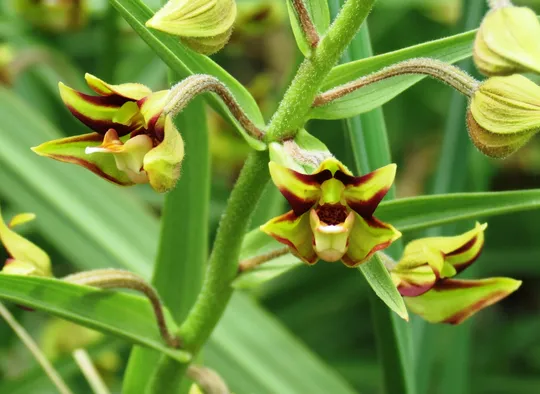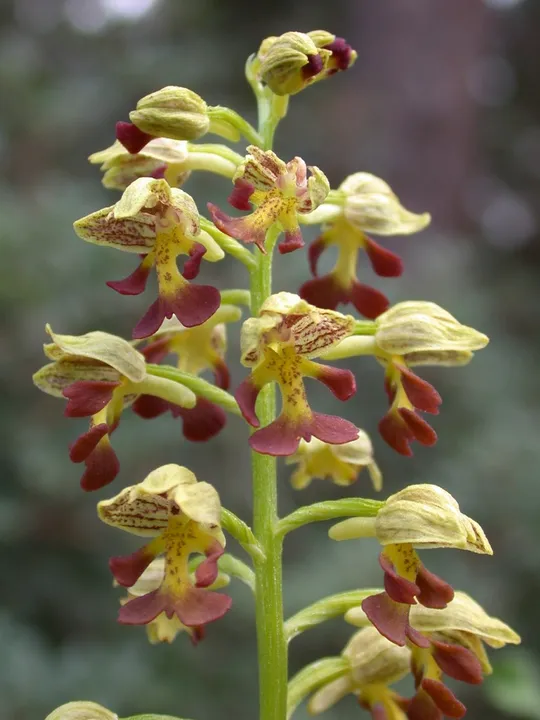Roman Orchid
Dactylorhiza romana




Dactylorhiza romana is a geophyte with a digitate tuber (hence the name Dactylorhiza – fingered), similar to the genus Orchis, but with white to pale yellow flowers, 15-27 cm tall. At the base of the stem are 2-3 brown bracts that clasp the linear, elongated, completely hairless leaves. The cylindrical inflorescence is at the top of a leafless stem and has, on average, nine flowers. The flowers are two lipped, laterally facing. The bracts are longer than the flowers. The perianth segments are elongated, 13mm long and 5 mm wide. The lateral segments are convex, the inner ones triangular and oval, 10 mm long and 4 mm wide. The plain oval flower lip extends forward and is 10-13 mm wide. It is divided into three short lobes, or occasionally entire. A 10-16-mm long spur extends straight out behind the flower. The fruit is a capsule with numerous tiny “powder like” seeds. All the Dactylorhiza species lack nectar in the spur and have "deceptive" flowers. D. romana blooms from late February to late March.
Dactylorhiza romana grows in single site in Israel – Mount Keta at the foot of Mount Hermon, near the settlement of Nimrod, at an altitude of 900 m. The species was first collected by Rani Kasher in 1985 below the Nimrod outpost. Tuvia Kushnir collected D. romana in Israel in 1944 in the Kziv Stream. In 1978, Bowman, the expert on Orchidaceae systematics, noticed a herbarium sheet of D. romana in the Orchidaceae file. The state of the flower did not allow it to be identified with certainty. However, the discovery of D. romana at the foot of Mount Hermon and the information that it grew in Lebanon, made it likely that this was probably the species collected by Kushnir in 1944.
Exposed limestone outcrops built of fossilized sponges from the upper Jurassic.
Dactylorhiza romana and its flowers are very similar to the genus Orchis from which it differs mainly in the structure of the tuber, which in Orchis is ovate and in Dactylorhiza is digitate. Both genera – Orchis and Dactylorhiza – are considered systematically close, and were only separated in recent years. Both genera have many species that hybridize creating intermediate forms that become the population base for new speciation. Unlike most of the Orchidaceae in Israel, D. romana has a yellowish-white flower with a labellum lacking punctuation or other decorations.
Dactylorhiza romana produces fruit only by cross-fertilization, by solitary bees, mainly of the genus Antofora. Andrena and Eucera male bees are also regular visitors. Although Dactylorhiza flowers do not offer any reward to the bees, they are favored by them over other kinds of Orchidaceae that bloom in the same place (Yahel, 1993).
• The Dactylorhiza romana site is located within the Hermon Reserve, but earthworks and development are threatening its habitat; one concentration of the plant was destroyed in 1993 following the construction of an electrical pole and the road leading to it.
• D. romana grows in a single site, which has three neighboring concentrations, which together number circa 100-300 plants. The population is stable, but there are annual fluctuations in the number of flowering plants (no accurate quantitative monitoring has been conducted yet).
• D. romana is common in the Mediterranean region, and in no danger of global extinction.
• The species was not within the borders of Israel in 1965 and therefore was not included in the legally protected list of endangered plants, however, the entire Orchidaceae family is protected by law.
• Six unique plants, unknown from other parts of Israel grow in the Dactylorhiza habitat: Potentilla reptans, Cerastium illyricum, Polygonum cognatum, Tessdalia coronopifolia, and Myosotis stricta. Twenty-two Orchidaceae were also recorded at the site. All these emphasize the importance preserving the D. romana site.
The area where Dactylorhiza romana grows on Mount Keta should be fenced. Strict demographic monitoring that includes the percentage of fruit production and establishment of new plants should be conducted.
Dactylorhiza romana grows in the central and eastern Mediterranean, penetrating into the Euro–Siberian region in the Pontic sub-region in the Black Sea: from southern Italy and Sicily through the Balkans, southern Bulgaria, Mediterranean Turkey, Cyprus and Syria-Lebanon; on the Black Sea coast of northern Turkey, the Crimean peninsula and the Bulgarian coast.
Dactylorhiza romana is a species in the Orchidaceae family that grows in a single location in a unique habitat, which is sensitive to the effects of development. It is a peripheral species growing at the foot of Mount Hermon at the southern edge of its range. Additional unique species can be found at the site where D. romana grows. All these make it site of major conservation importance.
דפני, א. 1986.דקטילוריזה רומאית – ממצא חדש ממרגלות החרמון. רתם 19: 20-25.
יהל, ג. 1993, האבקת האצבעית הרומאית בהר קטע. עבודת גמר, מחנה ביוטופ בבי"ס שדה חרמון.
Current Occupancy Map
| 1000 squre meter pixel | 5000 squre meter pixel | 10000 squre meter pixel | |
|---|---|---|---|
| number of observations | 0 | 0 | 0 |
| in total pixels | 0 | 0 | 0 |
| Family | orchidaceae |
| Classification | On the endangered species list |
| Ecosystem | Mediterranean |
| Chorotype | Mediterranean |
| Conservation Site | Mount Keta at the foot of Mount Hermon |
| Rarity |
1
6
6
|
|---|---|
| Vulnerability |
0
1
4
|
| Attractiveness |
0
1
4
|
| Endemism |
0
0
4
|
| Red number |
1
4.7
10
|
| Peripherality | 0 |
| IUCN category | DD EW EX LC CR EN VU NT |
| Threat Definition according to the red book | Endangered |
 Based on:
Based on:






